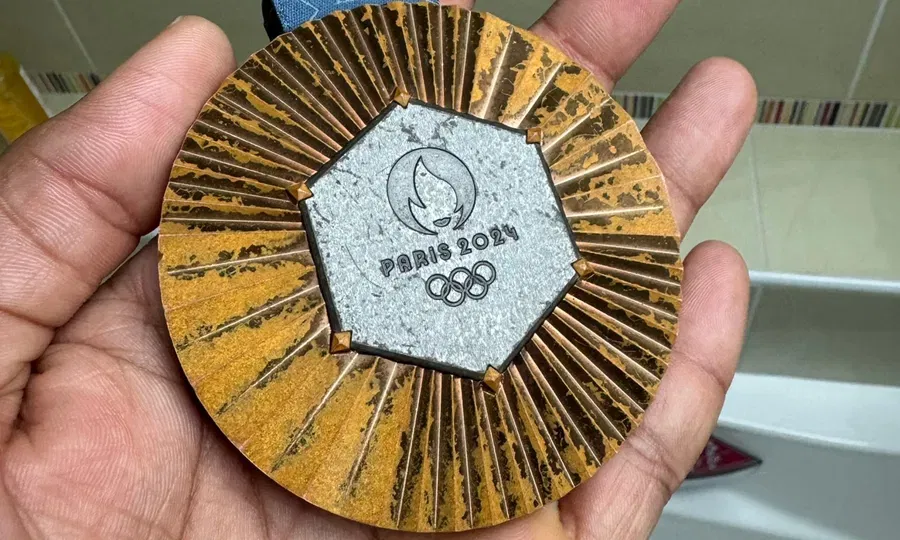
Imago
Unlicensed

Imago
Unlicensed
The 2024 Paris Olympics sure did take the world by storm. Unfortunately, the shine did not last. And that quite literally! Soon after, the Olympic season ended, athletes headed back home with their prized medals only to find out that it had already started to deteriorate. Athletes went on to talk about their tarnishing and flaking. The French swimmer Yohann Ndoye-Brouard, the bronze medalist in 4X100m, was not happy to see that his medal’s finish had changed. In fact, Yohann went on to call the finish “crocodile skin.” But he was not the only one!
Watch What’s Trending Now!
Skateboarder Nyjah Huston also went on to talk about how sweat and wear turned his bronze into a no-shine object. British diver Yasmin Harper wasn’t spared either, noting “small bits of tarnishing” on her bronze medal. It wasn’t long after the claims that photos of worn-out medals flooded social media. With Clement Secchi’s discolored medal from the 4×100-meter medley relay taking center stage. So the big question is, how could medals that are meant to last a lifetime flake away just months after the games?
ADVERTISEMENT
IOC was left with no choice but to admit mistakes!
The International Olympic Committee has broken the veil of silence and addressed the issues. In the months after Paris Olympics, the IOC and Monnaie de Paris, the medal manufacturer, have had over 100 medals returned. The French mint has finally come out and admitted that there were flaws in the varnishing process. But that’s not all; it also comes with a promise of action!
In the statement issued by the French Mint, they stated, “The Monnaie de Paris has taken the issue of damaged medals very seriously since the first exchange requests in August and has mobilized its internal teams.” But that’s not all that is being done! The medals will be replaced by the end of the “first quarter of 2025.” So how is this going to be done?
Top Stories
Tom Brady Hints at Nefarious Actions From Bears After Packers Lose Sideline Heaters

Another Almost Fatal Disaster Surfaces From Statesville Airport Amidst Ongoing Greg Biffle’s Crash Investigation

Prayers Pour In From Terrell Owens as 275lbs Former Cowboys Player Announces Major Health News

Josh Allen Makes Lifetime Buffalo Announcement as Pregnant Hailee Steinfeld Receives Bills QB’s Clear Family Plan

NTSB Appeals for Greg Biffle’s Wife’s Alleged In-Flight Text Messages as Crash Investigation Heats Up

Tiger Woods & Charlie Woods Paid Special Homage by Annika Sorenstam’s Son at PNC Championship

ADVERTISEMENT

ADVERTISEMENT
Well, national Olympic committees have been contacted, and a system has been put in place to ensure smooth exchanges. Additionally, the replaced medals will be identical to the ones that were awarded in Paris. While all is now good and varnishing faults have been admitted, how could a medal that claims to have iron from the Eiffel Tower deteriorate so fast? Additionally, there were 5,084 medals made. Can they all be replaced?
Each medal from the Paris Olympics might have had a piece of history, yet it wasn’t enough!
It is intriguing to consider that Paris 2024’s medals were symbolic of the French heritage. It was designed by Chaumet and embedded with pieces of original iron from the Eiffel Tower. A tower has not budged in nearly 138 years. Each medal weighed around 18 grams and carried a slice of history in its hexagonal design. Unfortunately, it seems the 97% copper and 2.5% zinc composition didn’t hold up to the Olympic standards!
ADVERTISEMENT

Reuters
The Eiffel Tower is seen through a net with a part of the logo of the Paris 2024 Olympic and Paralympic Games from the Trocadero square in Paris, France, July 3, 2024. REUTERS/Yara Nardi
5,084 medals were crafted, of which 2,600 were for the Olympics and the remaining for the Paralympics. IOC has rather boldly said, “Damaged medals will be systematically replaced by the Monnaie de Paris and engraved in an identical way to the originals.” While admitting mistakes and issuing replacements seem like a great move, will the French Mint be able to replace them all?
Athletes, for now, are left holding pieces of history that, ironically, seem better suited for display than durability. And last but not least, here’s to hoping that the next batch of medals can keep their shine!
ADVERTISEMENT
ADVERTISEMENT
ADVERTISEMENT
ADVERTISEMENT

